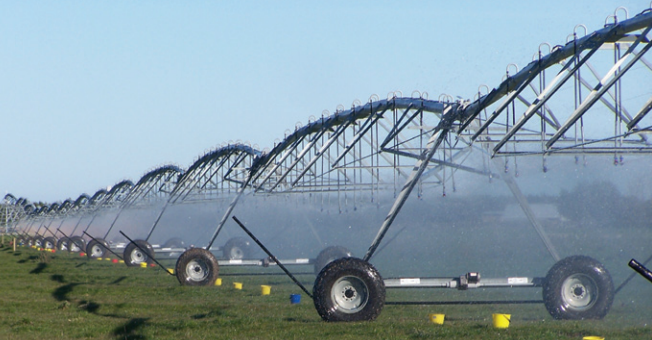Getting the best out of your overhead irrigator
 PRODUCTION ADVICE - AUGUST 2020 - AGRONOMY
PRODUCTION ADVICE - AUGUST 2020 - AGRONOMY
By Adrian Smith
Senior Land Services Officer - Mixed Farming Systems
P: 03 5881 9932 | M: 0447 778 515 | E: adrian.smith@lls.nsw.gov.au
 With the prospects of a potentially good irrigation season in front of us, it remains critical that irrigators get the most from their irrigation system investments (and the water they are applying).
With the prospects of a potentially good irrigation season in front of us, it remains critical that irrigators get the most from their irrigation system investments (and the water they are applying).
For those with overhead (centre pivot or lateral move) systems, doing some simple checks of how your machine(s) are operating will ensure you make ‘every drop count’.
Simple things to do include:
- inspecting your irrigator’s structural integrity
- ensuring your oil and grease points are serviced
- checking and servicing your drivelines, couplings and gearboxes
- making sure your control systems, automatic shutdown and wiring are in sound working order
- checking machine alignment and any guidance arms or cables
- checking your filters and trash screens
- checking the pressure of each tyre – correct tyre selection and pressure can help minimise wheel rutting
- checking the flow rate of your pump - to ensure it is delivering what it is supposed to
- measuring and checking your machine’s operating speed to ensure the correct calibrations and settings are in place
- replacing worn or broken sprinklers and pressure regulators, and checking the operating pressure at the pump, and middle and end of the machine.
Apart from mechanical servicing, the key areas that affect your irrigator’s performance are the operation of your sprinklers (and pressure regulators) and the operating pressure of your machine.
There is a rule of thumb that says your sprinkler package typically accounts for less than 10 per cent of the cost of a system, but has the biggest influence on irrigation performance. The bottom line is, if your current sprinkler pack is not doing the job, or is based on ‘old’ technology, a new sprinkler package can be a very wise investment.
Operating your machine at too high a pressure is costing you money (diesel or electricity), whereas too low a pressure often means not enough water is being applied to your crop. Make sure you are operating in the ‘sweet spot’ for your particular system. Buy a good pressure gauge and regularly check operating pressures.
There are three key measures that define the irrigation performance of your machine, and ultimately, the crop being irrigated:
1. Application rate - the depth/volume of water being applied.
2. Application uniformity - how evenly water is applied across the length of the machine.
3. Application efficiency - how much of the applied water is available for plants to use.
These can be checked with a ‘catch can’ test, where ‘cans’ are placed across the length of the operating machine, and the volume in each subsequently measured (see photo above). The results can be used to work out the application rate, and how uniformly water is being applied.
If you have done all the checks and everything is working as it should, you should also do some form of soil moisture monitoring. This will help you match plant water demands to your application rates and help maximise productivity.
Finally, don’t forget to actually get out in the field, especially when the irrigator is operating, to check that everything (both crop and machine) is performing as it should. If you don’t monitor and check what your system is doing and how it is performing, you can’t expect to maximise the benefits these systems can provide.
Further information on conducting tests on centre pivot and lateral move irrigators can be obtained by contacting your supplier, or speaking with me at the contact numbers above.